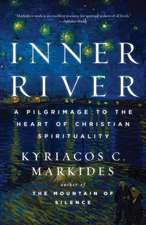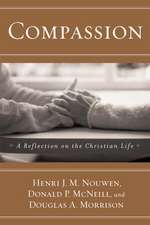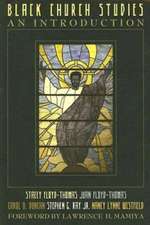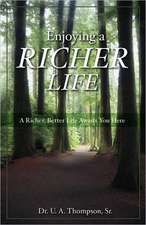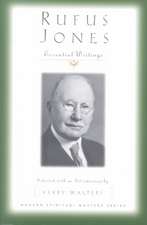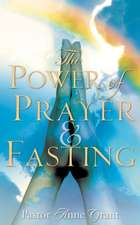The Saints' Guide to Happiness: Practical Lessons in the Life of the Spirit
Autor Robert Ellsbergen Limba Engleză Paperback – 31 aug 2005
In The Saints’ Guide to Happiness, Robert Ellsberg suggests that some of the best people to show us are holy men and women throughout history—from St. Augustine to Flannery O’Connor, Thomas Merton to St. Theresa of Avila and Mother Theresa.
These people weren’t saints because of the way they died or their visions or wondrous deeds. They were saints because of their extraordinary capacity for goodness and love, which—in the end—makes us happy.
Preț: 105.82 lei
Nou
Puncte Express: 159
Preț estimativ în valută:
20.26€ • 20.88$ • 17.08£
20.26€ • 20.88$ • 17.08£
Carte disponibilă
Livrare economică 07-21 februarie
Preluare comenzi: 021 569.72.76
Specificații
ISBN-13: 9780385515665
ISBN-10: 0385515669
Pagini: 221
Dimensiuni: 140 x 207 x 17 mm
Greutate: 0.21 kg
Editura: IMAGE
ISBN-10: 0385515669
Pagini: 221
Dimensiuni: 140 x 207 x 17 mm
Greutate: 0.21 kg
Editura: IMAGE
Notă biografică
Robert Ellsberg, a native of Los Angeles, became a Catholic in 1980 while a member of the Catholic Worker community in lower Manhattan. After studying theology at Harvard Divinity School he became Editor in Chief of Orbis Books, the publishing arm of Maryknoll. Married with three children, he lives in Ossining, New York. His other books include All Saints and Blessed Among All Women.
Extras
One
LEARNING TO BE ALIVE
We beg you, make us truly alive.
--Serapion of Thmuis
Mine, O thou lord of life, send my roots rain.
--Gerard Manley Hopkins
The sorrows of life are many. But sorrow is not the opposite of happiness. At least in sorrow we are aware of being alive. So often the problem is not really sorrow but the deadness that attends our daily existence. The pace and pressures of the world, the struggle to "make a living," the disquiet driven by constant advertising, the distracting drone of consumer culture--all these contribute to fatigue, numbness, an inability to feel anything at all. Our bodies may thrive--no generation has ever enjoyed such long life or good health--yet there is a sickness that eats away at our souls.
We can see it in the faces of commuters on a train or shoppers in the mall; too often it is in the face we encounter in the mirror. But we may also see it in the faces in church. Religion in itself offers no special immunity against deadness, especially when religious practice becomes simply another task to perform, a set of rules to obey. William Blake wrote scornfully of "priests in black gowns, walking their rounds, binding with briars my joys & desires."
Doubtless it often feels that way. But that is not the way it needs to be.
Of the flock in his care, Jesus said: "I came that they might have life and have it in abundance." Such life in abundance is one way of describing the meaning of happiness. It is an antidote to the kind of existence--dry and hollow--that dulls even the memory of our "joys & desires." Yet over the centuries too many Christians have transposed Christ's promise to the other side of death, thereby spurning the challenge to seek life and happiness in the present. Against this tendency St. Theophanis the Monk, one of the early desert fathers, warned, "Do not deceive yourself with idle hopes that in the world to come you will find life if you have not tried to find it in the present world."
St. Irenaeus, a second-century bishop and theologian, put it this way: "The glory of God is the human being fully alive." Irenaeus wrote these words to oppose a kind of spirituality that scorns material existence in the world. But his words pose a challenge for anyone who settles for a truncated life, whether reduced to work, entertainment, or an otherworldly spiritualism. To be fully alive--it was for this that we were created; it was toward this goal, as the saints remind us, that Christ pointed the way.
But we have lost our way.
ZEST FOR LIVING
What might it mean to be "fully alive"? Obviously it is not the same as simply eating and breathing. Nor is it expressed in a flurry of manic activity. To be fully alive is a matter of living out of the deepest part of oneself. Call it the heart or the soul; these are words that describe the central and intimate core of our being, the place where we are most truly ourselves. Given the noise and distractions that surround us, it is often hard to imagine that such places exist. We glide along the surface, taking our cues from the newspapers, or our neighbors, or the commercials on TV. They tell us what to desire, what to fear, and what will bring us joy. Yet the more we listen to such voices, the less we know ourselves. No wonder happiness is so elusive.
The men and women called saints have walked a different path, a path to God that was at the same time the path to their own true selves. There is much that they might teach us. Yet their authority as guides and teachers often fades in the shadow of an apparent "otherness" that renders them at once inaccessible and unappealing. To begin with, saints are supposed to be perfect people--"not like us." Traditional stories about their lives reinforce this impression, emphasizing miraculous and otherworldly traits while airbrushing anything recognizably human. On this basis we might share George Orwell's conclusion that the very aspiration to holiness is evidence of a warped personality. "Saints," he wrote, "should always be judged guilty until they are proved innocent."
Sentimental and saccharine hagiography is partly to blame. Dorothy Day wrote about coming across one book about saints that included this passage on their eating habits: "The saints went to their meals sighing. St. Alphonsus, when sitting down, would think only of the sufferings of the souls in purgatory, and with tears would beseech Our Lady to accept the mortifications he imposed upon himself during meals. Blessed de Montfort sometimes shed tears and sobbed bitterly when sitting at table to eat." To this, Day offered the brief comment: "No wonder no one wants to be a saint."
Yet Day herself conveyed something else. No one who ever observed how she savored a cup of instant coffee or the rare luxury of a fresh roll, how she enjoyed watching the shifting tides of Raritan Bay off Staten Island or listened raptly to the Saturday afternoon opera broadcasts on the radio could fail to detect the quality that Teilhard de Chardin described as a "zest for living": "that spiritual disposition, at once intellectual and affective, in virtue of which life, the world, and action seem to us, on the whole, luminous--interesting--appetizing."
As the otherworldly heroes of pious legend, saints may seem close to God but not exactly human. In fact, as Thomas Merton observed, sanctity is really a matter of being more fully human: "This implies a greater capacity for concern, for suffering, for understanding, for sympathy, and also for humor, for joy, for appreciation for the good and beautiful things of life." One observes those qualities in holy persons of recent times--Mother Teresa, or Pope John XXIII, or the Dalai Lama--a certain lightness of being, far from the torturous attitude of Blessed de Montfort toward his food. And it makes one wonder if a similar quality or aura did not surround the great saints of the past--whether St. Francis of Assisi, who built the first Christmas creche, or St. Teresa of Avila, who prayed to God to "deliver us from sour-faced saints," or St. Francis de Sales, who said that a "sad saint is a sad sort of saint." They stood out not just for their faith or good works but for exhibiting a certain quality of being. In traditional Christian art this aura was represented by a halo. Real saints have no such distinguishing marks. But the aura is real. It is the presence of life, life in abundance.
* * *
Far from that goal, mired in deadness, where does our road to happiness begin? It might begin with a certain restless disquiet, a sense of subtle dissatisfaction, the suspicion that "there must be more to life." Of course to this our culture has a ready answer: Indeed there is more, infinitely more--more things, more pleasures, more fun.
The world offers innumerable pleasures and distractions. But they cannot satisfy our deepest hunger. When we realize this, and if our disquiet remains intact, then we may find ourselves entering what Walker Percy, in The Moviegoer, calls the search: "The search is what anyone would undertake if he were not sunk in the everydayness of his own life. . . . To become aware of the possibility of the search is to be onto something. Not to be onto something is to be in despair."
The lineage of such searchers is long. It includes such a recent figure as Thomas Merton, self-described "complete twentieth-century man," who, at the dawn of World War II, abandoned the ambitions of his New York literary set to become a Trappist monk in rural Kentucky. Justifying this decision, he later wrote, "What I had abandoned when I 'left the world' and came to the monastery was the understanding of myself that I had developed in the context of civil society--my identification with what appeared to me to be its aims . . . the image of a society that is happy because it drinks Coca-Cola or Seagram's or both and is protected by the bomb."
The lineage reaches back to Henry David Thoreau, the nineteenth-century sage of New England. In 1845 he withdrew to a hermitage on Walden Pond, near Concord, seeking to escape a world in which "the mass of men lead lives of quiet desperation." He decried the condition of everyday life, which seemed to him no better than a kind of sleepwalking. "To be awake is to be alive," he wrote. "I have not yet met a man who was quite awake." And so he retreated for a while to the New England equivalent of the desert, hoping "to live deliberately, to front only the essential facts of life and see if I could learn what it had to teach, and not, when I came to die, discover that I had not lived."
It extends back considerably further . . .
TO THE DESERT
In the fourth century, just as Christianity had achieved a certain level of acceptance, there emerged a new phenomenon, a source of wonder and fascination to Christians in late Roman society. Men and women--at first a few intrepid pioneers but gradually large numbers--began drifting into the desert, their ranks gradually populating the seemingly un-inhabitable corners of Palestine, Arabia, Syria, and Egypt. Some gathered in small communities; others lived in remote and isolated caves or among abandoned ruins. In their solitude they occupied themselves with prayer and fasting, reflection on scripture, and simple labor.
What did they seek? The possible answers are many: to live more deliberately, to seek a narrower road to salvation, to overcome the deadness they perceived in the surrounding culture, to tap into the source of life. Yes, all this. And yet it is striking how often the stories of these desert pilgrims relate their quest to the pursuit of happiness. There is St. Simeon Stylites (d. 459), who, after hearing a reading of the Beatitudes, prayed that God would lead him on the path of happiness and was led, curiously enough, to construct a series of pillars (or stylites), progressively higher from the ground, upon which he spent the next thirty-seven years of his life. There is the story of St. Macarius of Egypt, whose very name comes from the Greek word for happiness. While crossing the Nile one day, he overheard a soldier remark on his cheerful demeanor and declared, "You have reason to call us happy, for this is our name. But if we are happy in despising the world, are not you miserable who live slaves to it?"
The most famous of these desert fathers was St. Antony, who died in 356 at the remarkable age of 105. Born into a prosperous Christian family in Upper Egypt, Antony found his life radically transformed one Sunday when he heard the gospel story of Jesus and the rich young man. He was particularly struck by Christ's injunction "Go sell what you possess and give to the poor, and you will have treasure in heaven." Others in church that day presumably heard the same text, but Antony took it to heart. In short order he proceeded to shed all his property and to make his way to the wilderness, eventually settling in an abandoned hilltop fort in the Arabian Desert. There he lived for the next twenty years, spending his time in prayer, contemplation, and the upkeep of his small garden. When a visiting philosopher asked him how he could be so happy without "the consolation of books," Antony replied, "My book is the nature of created things, and anytime I want to read the words of God, the book lies open before me."
His story is recounted in a book by St. Athanasius (d. 373), the bishop of Alexandria. The Life of Antony, written shortly after the saint's death, spares no detail of Antony's various austerities and ordeals: hunger, thirst, and lack of sleep, not to mention the dangers of lions, crocodiles, snakes, and scorpions. The most dramatic episodes, however, involve Antony's assault by a succession of demons, which appeared to him under various forms and guises--both hideous and alluring--to tempt him from his path. Yet after all these ordeals, when Antony finally reemerged after his many years of solitude, everyone marveled at his physical fitness, for he was "neither fat from lack of exercise, nor emaciated from fasting and combat with demons."
His inner equilibrium was equally impressive: "His soul being free of confusion, he held his outer senses also undisturbed, so that from the soul's joy his face was cheerful as well, and from the movements of the body it was possible to sense and perceive the stable condition of the soul." Eventually he consented to serve as the abbot of a community of monks. According to Athanasius, who knew him, "He was never troubled, his soul being calm, and he never looked gloomy, his mind being joyous."
The desert monastics had a name for this kind of equilibrium. They called it apatheia--quite a different thing from the indifference or listlessness associated with "apathy." For the desert monastics true life began when one was no longer a prisoner of such feelings as anger, fear, lust, and pride. When all these passions were pruned away, the result was not an absence of feeling, but apatheia--a balance and wholeness expressed in kindness, gentleness, and compassion: the "soul's joy" so evident in the face of Antony or the "happiness" observable in St. Macarius.
The Life of Antony was a popular success. It spawned a whole literature of similar vitae, thus feeding an appetite in late antiquity for stories of spiritual heroism. Among those infected by the power of this story was St. Augustine, later the bishop of Hippo and one of the towering figures in Christian history. In his Confessions he recounted how, on the eve of his conversion, he received a visitor named Ponticianus, a Christian "who held a high position in the Emperor's household." From this gentleman he first heard the story of St. Antony and found himself "astonished to hear of the wonders [God] had worked so recently, almost in our own times." (Augustine was born in 354, two years before Antony's death.)
Augustine's astonishment, however, was joined by a certain anguish. Though for some time he had intellectually embraced the logic of Christianity, he had found it impossible to reconcile his life with his newfound convictions. Like the rich young man of the gospels, "I still postponed my renunciation of this world's joys, which would have left me free to look for that other happiness, the very search for which, let alone its discovery, I ought to have prized above the discovery of all human treasures and kingdoms. . . . All the time that Ponticianus was speaking my conscience gnawed away at me like this."
To Augustine, Antony's story described the search for happiness. Antony had found it; Augustine wanted it too.
From a distance of sixteen hundred years, it is hard to appreciate the appeal of such a story. Our society tends to idealize self-fulfillment, not self-denial. And so, in contrast with the happiness afforded by life among the scorpions, the miseries of our present "slavery" may seem fond and familiar.
LEARNING TO BE ALIVE
We beg you, make us truly alive.
--Serapion of Thmuis
Mine, O thou lord of life, send my roots rain.
--Gerard Manley Hopkins
The sorrows of life are many. But sorrow is not the opposite of happiness. At least in sorrow we are aware of being alive. So often the problem is not really sorrow but the deadness that attends our daily existence. The pace and pressures of the world, the struggle to "make a living," the disquiet driven by constant advertising, the distracting drone of consumer culture--all these contribute to fatigue, numbness, an inability to feel anything at all. Our bodies may thrive--no generation has ever enjoyed such long life or good health--yet there is a sickness that eats away at our souls.
We can see it in the faces of commuters on a train or shoppers in the mall; too often it is in the face we encounter in the mirror. But we may also see it in the faces in church. Religion in itself offers no special immunity against deadness, especially when religious practice becomes simply another task to perform, a set of rules to obey. William Blake wrote scornfully of "priests in black gowns, walking their rounds, binding with briars my joys & desires."
Doubtless it often feels that way. But that is not the way it needs to be.
Of the flock in his care, Jesus said: "I came that they might have life and have it in abundance." Such life in abundance is one way of describing the meaning of happiness. It is an antidote to the kind of existence--dry and hollow--that dulls even the memory of our "joys & desires." Yet over the centuries too many Christians have transposed Christ's promise to the other side of death, thereby spurning the challenge to seek life and happiness in the present. Against this tendency St. Theophanis the Monk, one of the early desert fathers, warned, "Do not deceive yourself with idle hopes that in the world to come you will find life if you have not tried to find it in the present world."
St. Irenaeus, a second-century bishop and theologian, put it this way: "The glory of God is the human being fully alive." Irenaeus wrote these words to oppose a kind of spirituality that scorns material existence in the world. But his words pose a challenge for anyone who settles for a truncated life, whether reduced to work, entertainment, or an otherworldly spiritualism. To be fully alive--it was for this that we were created; it was toward this goal, as the saints remind us, that Christ pointed the way.
But we have lost our way.
ZEST FOR LIVING
What might it mean to be "fully alive"? Obviously it is not the same as simply eating and breathing. Nor is it expressed in a flurry of manic activity. To be fully alive is a matter of living out of the deepest part of oneself. Call it the heart or the soul; these are words that describe the central and intimate core of our being, the place where we are most truly ourselves. Given the noise and distractions that surround us, it is often hard to imagine that such places exist. We glide along the surface, taking our cues from the newspapers, or our neighbors, or the commercials on TV. They tell us what to desire, what to fear, and what will bring us joy. Yet the more we listen to such voices, the less we know ourselves. No wonder happiness is so elusive.
The men and women called saints have walked a different path, a path to God that was at the same time the path to their own true selves. There is much that they might teach us. Yet their authority as guides and teachers often fades in the shadow of an apparent "otherness" that renders them at once inaccessible and unappealing. To begin with, saints are supposed to be perfect people--"not like us." Traditional stories about their lives reinforce this impression, emphasizing miraculous and otherworldly traits while airbrushing anything recognizably human. On this basis we might share George Orwell's conclusion that the very aspiration to holiness is evidence of a warped personality. "Saints," he wrote, "should always be judged guilty until they are proved innocent."
Sentimental and saccharine hagiography is partly to blame. Dorothy Day wrote about coming across one book about saints that included this passage on their eating habits: "The saints went to their meals sighing. St. Alphonsus, when sitting down, would think only of the sufferings of the souls in purgatory, and with tears would beseech Our Lady to accept the mortifications he imposed upon himself during meals. Blessed de Montfort sometimes shed tears and sobbed bitterly when sitting at table to eat." To this, Day offered the brief comment: "No wonder no one wants to be a saint."
Yet Day herself conveyed something else. No one who ever observed how she savored a cup of instant coffee or the rare luxury of a fresh roll, how she enjoyed watching the shifting tides of Raritan Bay off Staten Island or listened raptly to the Saturday afternoon opera broadcasts on the radio could fail to detect the quality that Teilhard de Chardin described as a "zest for living": "that spiritual disposition, at once intellectual and affective, in virtue of which life, the world, and action seem to us, on the whole, luminous--interesting--appetizing."
As the otherworldly heroes of pious legend, saints may seem close to God but not exactly human. In fact, as Thomas Merton observed, sanctity is really a matter of being more fully human: "This implies a greater capacity for concern, for suffering, for understanding, for sympathy, and also for humor, for joy, for appreciation for the good and beautiful things of life." One observes those qualities in holy persons of recent times--Mother Teresa, or Pope John XXIII, or the Dalai Lama--a certain lightness of being, far from the torturous attitude of Blessed de Montfort toward his food. And it makes one wonder if a similar quality or aura did not surround the great saints of the past--whether St. Francis of Assisi, who built the first Christmas creche, or St. Teresa of Avila, who prayed to God to "deliver us from sour-faced saints," or St. Francis de Sales, who said that a "sad saint is a sad sort of saint." They stood out not just for their faith or good works but for exhibiting a certain quality of being. In traditional Christian art this aura was represented by a halo. Real saints have no such distinguishing marks. But the aura is real. It is the presence of life, life in abundance.
* * *
Far from that goal, mired in deadness, where does our road to happiness begin? It might begin with a certain restless disquiet, a sense of subtle dissatisfaction, the suspicion that "there must be more to life." Of course to this our culture has a ready answer: Indeed there is more, infinitely more--more things, more pleasures, more fun.
The world offers innumerable pleasures and distractions. But they cannot satisfy our deepest hunger. When we realize this, and if our disquiet remains intact, then we may find ourselves entering what Walker Percy, in The Moviegoer, calls the search: "The search is what anyone would undertake if he were not sunk in the everydayness of his own life. . . . To become aware of the possibility of the search is to be onto something. Not to be onto something is to be in despair."
The lineage of such searchers is long. It includes such a recent figure as Thomas Merton, self-described "complete twentieth-century man," who, at the dawn of World War II, abandoned the ambitions of his New York literary set to become a Trappist monk in rural Kentucky. Justifying this decision, he later wrote, "What I had abandoned when I 'left the world' and came to the monastery was the understanding of myself that I had developed in the context of civil society--my identification with what appeared to me to be its aims . . . the image of a society that is happy because it drinks Coca-Cola or Seagram's or both and is protected by the bomb."
The lineage reaches back to Henry David Thoreau, the nineteenth-century sage of New England. In 1845 he withdrew to a hermitage on Walden Pond, near Concord, seeking to escape a world in which "the mass of men lead lives of quiet desperation." He decried the condition of everyday life, which seemed to him no better than a kind of sleepwalking. "To be awake is to be alive," he wrote. "I have not yet met a man who was quite awake." And so he retreated for a while to the New England equivalent of the desert, hoping "to live deliberately, to front only the essential facts of life and see if I could learn what it had to teach, and not, when I came to die, discover that I had not lived."
It extends back considerably further . . .
TO THE DESERT
In the fourth century, just as Christianity had achieved a certain level of acceptance, there emerged a new phenomenon, a source of wonder and fascination to Christians in late Roman society. Men and women--at first a few intrepid pioneers but gradually large numbers--began drifting into the desert, their ranks gradually populating the seemingly un-inhabitable corners of Palestine, Arabia, Syria, and Egypt. Some gathered in small communities; others lived in remote and isolated caves or among abandoned ruins. In their solitude they occupied themselves with prayer and fasting, reflection on scripture, and simple labor.
What did they seek? The possible answers are many: to live more deliberately, to seek a narrower road to salvation, to overcome the deadness they perceived in the surrounding culture, to tap into the source of life. Yes, all this. And yet it is striking how often the stories of these desert pilgrims relate their quest to the pursuit of happiness. There is St. Simeon Stylites (d. 459), who, after hearing a reading of the Beatitudes, prayed that God would lead him on the path of happiness and was led, curiously enough, to construct a series of pillars (or stylites), progressively higher from the ground, upon which he spent the next thirty-seven years of his life. There is the story of St. Macarius of Egypt, whose very name comes from the Greek word for happiness. While crossing the Nile one day, he overheard a soldier remark on his cheerful demeanor and declared, "You have reason to call us happy, for this is our name. But if we are happy in despising the world, are not you miserable who live slaves to it?"
The most famous of these desert fathers was St. Antony, who died in 356 at the remarkable age of 105. Born into a prosperous Christian family in Upper Egypt, Antony found his life radically transformed one Sunday when he heard the gospel story of Jesus and the rich young man. He was particularly struck by Christ's injunction "Go sell what you possess and give to the poor, and you will have treasure in heaven." Others in church that day presumably heard the same text, but Antony took it to heart. In short order he proceeded to shed all his property and to make his way to the wilderness, eventually settling in an abandoned hilltop fort in the Arabian Desert. There he lived for the next twenty years, spending his time in prayer, contemplation, and the upkeep of his small garden. When a visiting philosopher asked him how he could be so happy without "the consolation of books," Antony replied, "My book is the nature of created things, and anytime I want to read the words of God, the book lies open before me."
His story is recounted in a book by St. Athanasius (d. 373), the bishop of Alexandria. The Life of Antony, written shortly after the saint's death, spares no detail of Antony's various austerities and ordeals: hunger, thirst, and lack of sleep, not to mention the dangers of lions, crocodiles, snakes, and scorpions. The most dramatic episodes, however, involve Antony's assault by a succession of demons, which appeared to him under various forms and guises--both hideous and alluring--to tempt him from his path. Yet after all these ordeals, when Antony finally reemerged after his many years of solitude, everyone marveled at his physical fitness, for he was "neither fat from lack of exercise, nor emaciated from fasting and combat with demons."
His inner equilibrium was equally impressive: "His soul being free of confusion, he held his outer senses also undisturbed, so that from the soul's joy his face was cheerful as well, and from the movements of the body it was possible to sense and perceive the stable condition of the soul." Eventually he consented to serve as the abbot of a community of monks. According to Athanasius, who knew him, "He was never troubled, his soul being calm, and he never looked gloomy, his mind being joyous."
The desert monastics had a name for this kind of equilibrium. They called it apatheia--quite a different thing from the indifference or listlessness associated with "apathy." For the desert monastics true life began when one was no longer a prisoner of such feelings as anger, fear, lust, and pride. When all these passions were pruned away, the result was not an absence of feeling, but apatheia--a balance and wholeness expressed in kindness, gentleness, and compassion: the "soul's joy" so evident in the face of Antony or the "happiness" observable in St. Macarius.
The Life of Antony was a popular success. It spawned a whole literature of similar vitae, thus feeding an appetite in late antiquity for stories of spiritual heroism. Among those infected by the power of this story was St. Augustine, later the bishop of Hippo and one of the towering figures in Christian history. In his Confessions he recounted how, on the eve of his conversion, he received a visitor named Ponticianus, a Christian "who held a high position in the Emperor's household." From this gentleman he first heard the story of St. Antony and found himself "astonished to hear of the wonders [God] had worked so recently, almost in our own times." (Augustine was born in 354, two years before Antony's death.)
Augustine's astonishment, however, was joined by a certain anguish. Though for some time he had intellectually embraced the logic of Christianity, he had found it impossible to reconcile his life with his newfound convictions. Like the rich young man of the gospels, "I still postponed my renunciation of this world's joys, which would have left me free to look for that other happiness, the very search for which, let alone its discovery, I ought to have prized above the discovery of all human treasures and kingdoms. . . . All the time that Ponticianus was speaking my conscience gnawed away at me like this."
To Augustine, Antony's story described the search for happiness. Antony had found it; Augustine wanted it too.
From a distance of sixteen hundred years, it is hard to appreciate the appeal of such a story. Our society tends to idealize self-fulfillment, not self-denial. And so, in contrast with the happiness afforded by life among the scorpions, the miseries of our present "slavery" may seem fond and familiar.
Recenzii
“Robert Ellsberg regards saints as friends worth knowing . . . for their uncommon wisdom as people who discovered that happiness and holiness are the same thing.”
—Kenneth L. Woodward, author of Making Saints
“. . . neither a quick-fix nor a stiff tone, but a modern, refreshing guide to a true life and the kind of happiness that lasts.”
—Nora Gallagher, author of Practicing Resurrection
—Kenneth L. Woodward, author of Making Saints
“. . . neither a quick-fix nor a stiff tone, but a modern, refreshing guide to a true life and the kind of happiness that lasts.”
—Nora Gallagher, author of Practicing Resurrection
Descriere
Ellsberg suggests that some of the best people to demonstrate how to experience happiness are holy men and women throughout history--from St. Augustine to Mother Theresa--people who were saints because of their extraordinary capacity for goodness and love. 12,500

